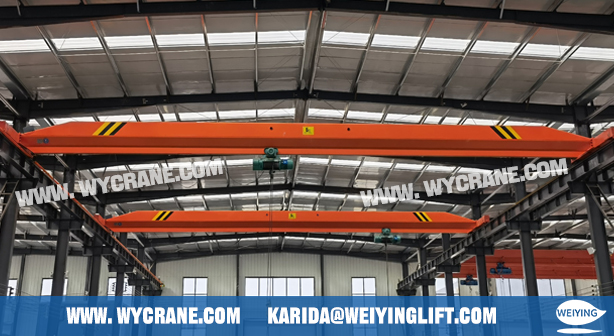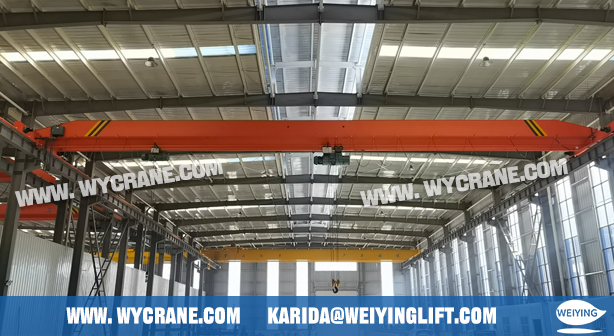Overhead crane installation is a critical process that determines the performance, reliability, and safety of your lifting operations for years to come. Whether you are installing a single girder overhead crane in a workshop or a double girder bridge crane in a large warehouse, a systematic installation process ensures the crane operates smoothly and meets global safety standards.
This comprehensive guide explains each stage of the installation process in detail—preparation, electrical system setup, mechanical assembly, commissioning, and load testing—helping overseas buyers, engineers, and project managers fully understand how a professional overhead crane installation is carried out.
 |
 |
Preparation is the foundation of a safe and successful installation. Sufficient planning makes the installation process smoother, reduces on-site risks, and ensures the bridge crane system matches the customer’s building structure and lifting requirements.
Before installation begins, a complete definition of the project scope is necessary. This includes:
Crane type: workshop overhead crane, warehouse overhead crane, underhung crane, etc.
Technical specifications: lifting capacity, lifting height, span, duty class (A3–A5), and working environment
Installation tools, lifting machinery, manpower, and time schedule
Coordination with building engineers, electrical technicians, and safety supervisors
A clearly defined installation scope ensures the crane components, runway beams, electrical systems, and safety devices all match the site conditions. It also helps avoid delays caused by missing equipment or unclear responsibilities.
A detailed inspection of the building ensures that the site is ready for installing an overhead crane. Key points include:
Dimensions and structure: Check the workshop height, width, and building column spacing
Runway beam support: Confirm that beams or columns can safely bear wheel loads
Clearances: Ensure there is enough space for crane movement and maintenance
Obstructions: Identify pipes, lights, HVAC ducts, or other equipment that may interfere
This step is especially important in warehouse retrofits or modernization projects, where existing structures may require strengthening.
Installing a crane involves heavy lifting, electrical wiring, and working at height. Therefore, hazard identification must include:
Risk of falling when working on runway beams or walkways
Electrical risks during wiring and testing
Crane component lifting risks when hoisting girders and hoists
Restricted zone markings to protect workers on the ground
By setting up PPE requirements, fall-protection equipment, and safe lifting procedures, the installation team ensures compliance with OSHA, CE, ISO, and other international safety standards.
The runway is the “track” on which the overhead crane operates. Its accuracy directly affects long-term performance. Technicians should inspect:
Rail alignment, straightness, and parallelism
Rail joints, bolts, clips, and welding quality
Rail elevation difference within the allowable tolerance
End stops at both ends of the runway
Power supply system for the crane (festoon system or conductor bar)
A precise runway ensures the crane travels smoothly without skewing or excessive wheel wear.
Electrical installation is completed before the full mechanical assembly to ensure safer wiring, easier access, and step-by-step functional verification. The electrical system is the “nerve center” of the crane, controlling lifting, travel, braking, and safety features.
Based on the customer’s plant layout, climate, and duty cycle, the crane may use:
C-track festoon cable system (common in workshops)
Conductor bar system (popular in heavy-duty industrial cranes)
Enclosed busbar system (ideal for dusty or corrosive environments)
Cable reel system (for long travel distances)
Proper installation ensures stable power transmission without overheating, voltage drop, or cable wear.
This stage involves connecting and routing all electrical circuits of the crane:
Main power line from the building distribution panel
Bridge travel power and control cables
Trolley travel control wiring
Hoist lifting motor wiring and brake connections
Wiring of limit switches and safety sensors
Engineers must follow strict cable-routing rules to prevent abrasion, electromagnetic interference, or wiring mix-ups. Each wire is labeled according to international standards to support future maintenance.
Depending on the application, the crane may be equipped with:
Pendant control
Wireless remote control
Cabin control (for heavy-duty steel mills or foundries)
During installation, the team ensures:
Correct directional responses
Stable communication signals
No delay or misoperation
Emergency stop functions work reliably
A well-configured control system enhances operator experience and improves workplace safety.
Key safety protections include:
Upper and lower hoisting limit switches
Trolley and bridge travel limit switches
Overload limiter
Thermal protection for motors
Emergency stop circuits
Anti-collision sensors (optional for multi-crane workshops)
These devices prevent accidents and extend the lifespan of the crane system.
After the electrical foundations are prepared, the mechanical installation begins.
Major crane components are assembled on the ground to ensure accuracy and reduce work at height:
Single girder or double girder
End trucks / end carriages
Hoist or trolley unit
Walkways, maintenance platforms, and railings
Ground assembly allows engineers to adjust alignment and check bolt torque before lifting the components into place.
The typical installation sequence is:
Lifting and positioning end trucks on the runway
Securing them to the rails
Hoisting the main girder and connecting it to the end trucks
Checking wheel pressure, alignment, and side clearances
Accurate installation ensures smooth, stable crane movement and minimizes mechanical wear.
After the bridge structure is secured:
The electric wire rope hoist or chain hoist is mounted on the girder
Motors, brakes, wheels, and reducers are checked
Trolley travel tests are conducted
Lubrication is applied to moving parts
A properly installed hoist ensures safe lifting and reduces equipment downtime.
Before a bridge crane installation can enter service, it must pass strict commissioning and load testing to verify performance, safety, and reliability.
Technicians perform:
Structural and mechanical inspections
Motor starting tests
Brake and limit switch adjustments
Noise, vibration, and heating checks
Hoist and trolley travel smoothness tests
This ensures every subsystem performs according to design requirements.
Load testing is mandatory for all overhead cranes:
Static load test (125% rated capacity):
Evaluates structural strength and deflection limits.
Dynamic load test (110% rated capacity):
Tests lifting, lowering, braking, and travel performance with load.
Only after passing both tests can the crane be delivered for actual production use.
Professional overhead crane installation is essential for safety, durability, and efficient material handling. By following a systematic process—preparation, electrical system installation, mechanical assembly, and final testing—you ensure your workshop overhead crane, warehouse bridge crane, or industrial lifting system performs reliably for many years.
With 34 years of manufacturing experience and 12 years of export expertise, we have built a dual advantage of professional qualifications and a global presence. Our business covers more than 100 countries and regions across Asia, Europe, the Americas, Africa, and Oceania. We are certified under the ISO management system and hold CE product certifications. Our main product lines include six major series—electric hoists, electric winches, gantry cranes, bridge cranes, marine cranes, and portal cranes—comprising nearly 100 different models.
If you want to learn more, please contact us.
E-mail address: karida@weiyinglift.com
Website: www.wycrane.com